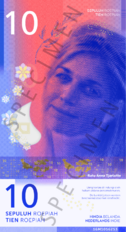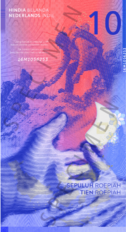Roepiah
| Roepiah | |||||
|---|---|---|---|---|---|
| Roepiah Hindia Belanda Nederlands-Indische Roepiah | |||||
| |||||
| ISO 4217 | |||||
| Code | HBR | ||||
| Denominations | |||||
| Subunit | |||||
| 1/100 | sen | ||||
| Plural | roepiahs | ||||
| sen | cents | ||||
| Symbol | ƒ (defunct) | ||||
| sen | c | ||||
| Nickname | duit | ||||
| Banknotes | 10, 20, 50, 100, 200, 1000 roepiahs | ||||
| Coins | 20c, 50c 1, 2, 5 roepiahs | ||||
| Demographics | |||||
| User(s) | |||||
| Issuance | |||||
| Central bank | Central Bank of Hindia Belanda | ||||
| Website | banksentral.hb | ||||
| Printer | Central Bank of Hindia Belanda | ||||
| Mint | Central Bank of Hindia Belanda | ||||
| Valuation | |||||
| Pegged with | NSD | ||||
| ERM | |||||
| Since | 2015 | ||||
| Fixed rate since | 2015 | ||||
| € = | HBR 7.5 | ||||
The Roepiah (Indonesian: Roepiah Hindia Belanda; Dutch: Nederlands-Indische Roepiah) is the currency of Hindia Belanda, being legal tender in both Hindia Belanda and Noordenstaat, alongside the Noordenstaatian guilder. The banknotes and coins of the Roepiah are issued and minted by the Central Bank of Hindia Belanda.
The Roepiah is subdivided into the sen, a hundredth of a roepiah. The ISO 4217 code of the Roepiah is HBR, although the older guilder symbol ‘ƒ’, deriving from the colonial era money of the same name, remains in use to some extent in retail and advertisements within Hindia Belanda. The Roepiah is also colloquially called “duit”, a remnant from the Company Era prior to 1800.
The official abbreviation for indicating price within Hindia Belanda, as regulated by the Central Bank of Hindia Belanda, is “HBR”. The abbreviation is usually placed in front of the value in figures. When the price of a good or service does not include a *sen*, the possible ".00" is replaced by ".-". For instance, “five roepiahs” is usually written as "HBR 5.-". In practice, few businesses in Hindia Belanda adhere to this official abbreviation, with most retaining the “.00”.
History
Prior to Hindia Belandan independence in 1929, the currency of the Colony of Hindia Belanda was called the ‘Gulden’. The Gulden was issued by De Javasche Bank (later becoming the Central Bank of Hindia Belanda) in Batavia, whose value corresponded to the Noordenstaatian Guilder at the time. During the colonial period from 1800 until 1929, several variants of the Hindia Belandan Gulden banknote were issued by non-government printers, most notably Bibliotek Kartieni, bearing unique design that reflected the various cultures of the Hindia Belandan archipelago. From 1910 until 1929, the Auxiliary Imamate also issued its own variant of the Hindia Belandan Gulden.
Upon Hindia Belandan independence, the Gulden was officially renamed as the Roepiah, although the former name still appeared on banknotes issued up until 1960. The right to print banknotes previously accorded to different printers and authorities in Colonial Hindia Belanda was also revoked, making the Central Bank of Hindia Belanda the sole printer of Roepiah banknotes.
An agreement as part of the Transfer of Sovereignty Instrument, entered into by Hindia Belanda and Noordenstaat following the former’s independence, made the Roepiah and the Noordenstaatian Guilder legal tender in both countries, exchangeable at a rate of one-for-one. Due to this monetary agreement between the two countries, banknotes of the Hindia Belandan Roepiah and the Noordenstaatian Guilder are in wide circulation in Hindia Belanda and Noordenstaat. Within Hindia Belanda, Noordenstaatian Guilder banknotes are considered Roepiah banknotes. The reverse is also true in Noordenstaat.
Banknotes
Since 1929, seven series of the Roepiah banknote have been issued. The 1929 series, issued by De Javasche Bank prior to its renaming as the Central Bank of Hindia Belanda, featured illustrations of Hindia Belandan flora on the obverse and various batik patterns on the reverse. It is the only banknote series that does not feature a person. Subsequent series of the Roepiah have all featured a person on the obverse.
The 2006 series was the first to be printed on polymer.
In 2010, the Central Bank of Hindia Belanda announced its plan to introduce a new series of the Roepiah, which began circulation in June 2014. The 2014 series was the first to be oriented vertically and to use a special hybrid polymer-cotton material comprising of four layers, bound by metallic micro threads that interlock.
The latest 2019 series began development in 2016, with printing commencing in 2018, although it was kept in secret until three months prior to the release of its 10 Roepiah banknote. The Central Bank of Hindia Belanda announced the 2019 series through a tweet sent via its official twitter account. The first banknote of the 2019 series to be released was the 10 Roepiah banknote, featuring Queen Anne-Charlotte on the obverse and a mountaineering scene on the reverse, with a closeup of a hand helping another hand. The 10 Roepiah banknote was revealed at a private unveiling party in Kartinituin, Jakarta. It was revealed that the portrait of Queen Anne-Charlotte on the obverse of the 10 Roepiah banknote is based on a selfie taken by the Queen, at the request of Soetrisna Mitski, the Governor of the Central Bank of Hindia Belanda. The 20 Roepiah banknote was revealed in early 2020 with limited circulation, due to the Asterovirus pandemic. The 20 Roepiah note features Pierre Tendean on the obverse and a rowing scene, with a close-up of a rower’s hands in action, on the reverse side.
Between the introductions of the 2014 and 2019 series, the Central Bank of Hindia Belanda had developed and printed a reserve series that was ready to be circulated in the event of widespread counterfeiting of the 2014 series. This series was never circulated, nor its design made public.
2019 (current series)
- 2019 (current) series of the Roepiah
2014 (legal tender) series
- 2014 (legal tender) series of the Roepiah
2003 series
- 2003 series of the Roepiah












